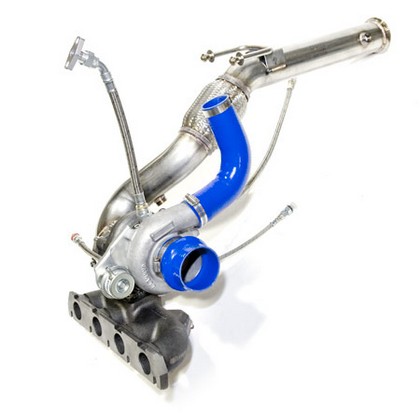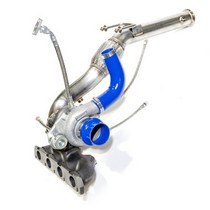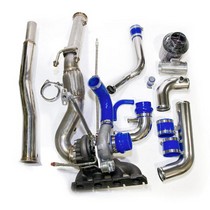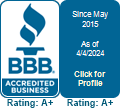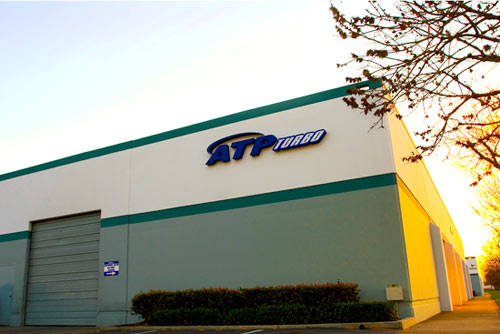Hello, Sign In!
Select Your Vehicle
Select Your Vehicle
ATP's GT28RS Turbo Kit With Red Silicone Connectors


Part #: ATP-VVW-192-red
$2,895.00 For kit
Free Shipping! *to continental U.S. only
Featured Videos
-
Video Description:Check out this Andy's Auto Sport TV episode where we explain what the differences are between superchargers and turbo kits!
-
Video Description:Boosting your vehicle is a major expense, so make sure you protect your investment correctly by checking out this video about forced induction and fuel usage. In this video:
*At 0:22, we tell you about what fuel supercharger manufacturers recommend you use and why. -
Video Description:When is one turbo just not enough? Check out this video to find out if and when you should install a twin turbo setup on your ride, or if a single turbo setup is more than adequate for your application. Here are some highlights:
*At 1:01, we discuss the benefits of sequential twin turbo systems, including fast spool-up times.
*At 1:25, we show you how conventional twin turbo systems are different than sequential setups.
*At 1:43, we discuss how, with a properly sized turbo, turbo lag is a thing of the past.
*At 2:22, we answer the ultimate question: are twin turbos really better than a single turbo? -
Video Description:Having the right spark plugs in forced induction applications is important, and in this video we'll tell you why. Highlights include:
*At 0:20, we explain why the right spark plugs and plug gap make a difference.
*At 0:58, we give our recommendations for choosing the proper spark plug gap for turbo and supercharged applications. -
Video Description:In this video, we tell you if it's okay to add forced induction (turbo or supercharger) to your otherwise stock engine. Highlights include:
*At 0:17, we tell you how to determine if your engine is ready for boost.
*At 0:30, we tell you how buying quality forced induction parts will help protect your engine.
*At 0:50, we talk about tuning your vehicle for power and reliability.
Fits On:
Audi A3 2.0T FSI FWD 350HP, Volkswagen GTI 2.0T FSI FWD 350HP, Volkswagen Jetta 2.0T FSI FWD 350HP
Description:
350HP GT28RS Turbo Kit for 2.0T FSI FWD (Front wheel drive model) VW GTI/Jetta and Audi A3. Internally wastegated design using the popular GT28RS dual ball bearing turbo with all the complimentary components including 3" downpipe and 3" inlet pipe. Add you preferred tuning solution and go.
350HP GT28RS Turbo Kit for 2.0T FSI FWD (Front wheel drive model) VW GTI/Jetta and Audi A3. Internally wastegated design using the popular GT28RS dual ball bearing turbo with all the complimentary components including 3" downpipe and 3" inlet pipe. Add you preferred tuning solution and go.
ATP Turbo, based out of Hayward, California, covers nearly every forced-induction platform out there.ATP produces high-quality products for specific needs with their high-tech milling and machining equipment. In addition, ATP uses industry-leading machining processes to develop their products in a short period of time.
Featured Videos
-
Video Description:Check out this Andy's Auto Sport TV episode where we explain what the differences are between superchargers and turbo kits!
-
Video Description:Boosting your vehicle is a major expense, so make sure you protect your investment correctly by checking out this video about forced induction and fuel usage. In this video:
*At 0:22, we tell you about what fuel supercharger manufacturers recommend you use and why. -
Video Description:When is one turbo just not enough? Check out this video to find out if and when you should install a twin turbo setup on your ride, or if a single turbo setup is more than adequate for your application. Here are some highlights:
*At 1:01, we discuss the benefits of sequential twin turbo systems, including fast spool-up times.
*At 1:25, we show you how conventional twin turbo systems are different than sequential setups.
*At 1:43, we discuss how, with a properly sized turbo, turbo lag is a thing of the past.
*At 2:22, we answer the ultimate question: are twin turbos really better than a single turbo? -
Video Description:Having the right spark plugs in forced induction applications is important, and in this video we'll tell you why. Highlights include:
*At 0:20, we explain why the right spark plugs and plug gap make a difference.
*At 0:58, we give our recommendations for choosing the proper spark plug gap for turbo and supercharged applications. -
Video Description:In this video, we tell you if it's okay to add forced induction (turbo or supercharger) to your otherwise stock engine. Highlights include:
*At 0:17, we tell you how to determine if your engine is ready for boost.
*At 0:30, we tell you how buying quality forced induction parts will help protect your engine.
*At 0:50, we talk about tuning your vehicle for power and reliability.
Q: What do turbo kits come with?
A: Complete turbo kits normally include the manifold, turbocharger, intake, down pipe, fuel management unit and all lines and hoses needed. You need to purchase intercoolers, piping, blow-off valves separately in most cases, unless otherwise noted in our product descriptions.
Q: What is a turbo? Why buy a turbo?
A: Think of a turbocharger as a fan that is blowing compressed air into your engine. The more air you give your engine, the more power your engine can give you. The extra air adds oxygen so you can burn more fuel. Turbochargers are powered by the exhaust gases generated by your engine after combustion. The time the turbo takes to spool up is seen by the driver as lag, or delay time. The driver may mash the throttle, but the engine won't produce power until the turbocharger is up to speed. The reason a turbo kit is such a great purchase is that it takes a tremendous amount of money and time to successfully increase the power of a naturally aspirated engine. Expensive head packages, along with expensive bottom block parts, will surely put a dent in your wallet while only making meager horsepower gains. With a bolt-on turbocharger kit you can obtain instant, very dramatic horsepower gains with less time and money while still having the potential for upgrading. The whistle of a blow off valve, the roar from an external wastegate, and the burst of power that makes your engine feel like it doubled in size, how could you resist?
Q: What is a turbo kit? Why buy a turbo kit?
A: Think of a turbocharger as a fan that is blowing compressed air into your engine. The more air you give your engine, the more power your engine can give you. The extra air adds oxygen so you can burn more fuel. Turbochargers are powered by the exhaust gases generated by your engine after combustion. The time the turbo takes to spool up is seen by the driver as lag, or delay time. The driver may mash the throttle, but the engine won't produce power until the turbocharger is up to speed. The reason a turbo kit is such a great purchase is that it takes a tremendous amount of money and time to successfully increase the power of a naturally aspirated engine. Expensive head packages, along with expensive bottom block parts, will surely put a dent in your wallet while only making meager horsepower gains. With a bolt-on turbocharger kit you can obtain instant, very dramatic horsepower gains with less time and money while still having the potential for upgrading. The whistle of a blow off valve, the roar from an external wastegate, and the burst of power that makes your engine feel like it doubled in size, how could you resist?
Q: Is there a pre-condition my vehicle needs to meet in order to be able to handle a turbo kit?
A: Any vehicle can be turbocharged but you must consider whether all of the engine, driveline, and chassis parts can handle big power increases. Most aftermarket turbocharger kits for naturally aspirated cars recommend running no more than 6-8 psi to prevent engine damage.
Q: How do you install a turbo kit?
A: Turbochargers should be installed by professionals if you have no experience with turbo installations. If you've done the basic bolt-on performance modifications to your car (intake, header, exhaust) and know your way around your engine, then you might be capable of doing the install yourself. Normal installation depending on the vehicle takes around 20-25 hours in most cases, but depends on whether custom work needs to be done. The turbo manifold that comes with the kit replaces the factory exhaust manifold. The turbo doesn't replace anything assuming this is a turbo kit and not a turbo upgrade kit. The turbo is mounted to a flange on the turbo manifold. Remember the turbo is spooled by the exhaust gases, so once the gases pass through the turbo manifold, it spools the turbo.
A: Complete turbo kits normally include the manifold, turbocharger, intake, down pipe, fuel management unit and all lines and hoses needed. You need to purchase intercoolers, piping, blow-off valves separately in most cases, unless otherwise noted in our product descriptions.
Q: What is a turbo? Why buy a turbo?
A: Think of a turbocharger as a fan that is blowing compressed air into your engine. The more air you give your engine, the more power your engine can give you. The extra air adds oxygen so you can burn more fuel. Turbochargers are powered by the exhaust gases generated by your engine after combustion. The time the turbo takes to spool up is seen by the driver as lag, or delay time. The driver may mash the throttle, but the engine won't produce power until the turbocharger is up to speed. The reason a turbo kit is such a great purchase is that it takes a tremendous amount of money and time to successfully increase the power of a naturally aspirated engine. Expensive head packages, along with expensive bottom block parts, will surely put a dent in your wallet while only making meager horsepower gains. With a bolt-on turbocharger kit you can obtain instant, very dramatic horsepower gains with less time and money while still having the potential for upgrading. The whistle of a blow off valve, the roar from an external wastegate, and the burst of power that makes your engine feel like it doubled in size, how could you resist?
Q: What is a turbo kit? Why buy a turbo kit?
A: Think of a turbocharger as a fan that is blowing compressed air into your engine. The more air you give your engine, the more power your engine can give you. The extra air adds oxygen so you can burn more fuel. Turbochargers are powered by the exhaust gases generated by your engine after combustion. The time the turbo takes to spool up is seen by the driver as lag, or delay time. The driver may mash the throttle, but the engine won't produce power until the turbocharger is up to speed. The reason a turbo kit is such a great purchase is that it takes a tremendous amount of money and time to successfully increase the power of a naturally aspirated engine. Expensive head packages, along with expensive bottom block parts, will surely put a dent in your wallet while only making meager horsepower gains. With a bolt-on turbocharger kit you can obtain instant, very dramatic horsepower gains with less time and money while still having the potential for upgrading. The whistle of a blow off valve, the roar from an external wastegate, and the burst of power that makes your engine feel like it doubled in size, how could you resist?
Q: Is there a pre-condition my vehicle needs to meet in order to be able to handle a turbo kit?
A: Any vehicle can be turbocharged but you must consider whether all of the engine, driveline, and chassis parts can handle big power increases. Most aftermarket turbocharger kits for naturally aspirated cars recommend running no more than 6-8 psi to prevent engine damage.
Q: How do you install a turbo kit?
A: Turbochargers should be installed by professionals if you have no experience with turbo installations. If you've done the basic bolt-on performance modifications to your car (intake, header, exhaust) and know your way around your engine, then you might be capable of doing the install yourself. Normal installation depending on the vehicle takes around 20-25 hours in most cases, but depends on whether custom work needs to be done. The turbo manifold that comes with the kit replaces the factory exhaust manifold. The turbo doesn't replace anything assuming this is a turbo kit and not a turbo upgrade kit. The turbo is mounted to a flange on the turbo manifold. Remember the turbo is spooled by the exhaust gases, so once the gases pass through the turbo manifold, it spools the turbo.
If you live in California, please note this item may be subject to a Proposition 65 warning. Click here to learn more.
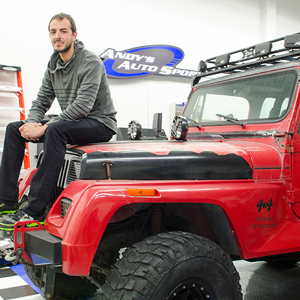


When you click on links to various merchants on this site and make a purchase, this can result in this site earning a commission. Affiliate programs and affiliations include, but are not limited to, the eBay Partner Network.
Not able to find what you are looking for?


Complete Turbo Turbocharger & Kit for Chevy Cruze Sonic Trax & Buick Encore 1.4L

T3/T4 T04E Universal Turbo Turbocharger Kit + Intercooler + Pipe +BOV +Wastegate

T3 T4 T04E Universal Turbo Stage III+Wastegate+Turbo Intercooler+piping Kit

T3 T4 T04E Universal Turbo Kit Stage III+Wastegate+Turbo Intercooler+piping

Upgrade Turbo Repair Rebuild Kit for Cummins 6.7L Holset HE300VG Turbo 3771664


